Introduction: The Love for Naan
Who doesn’t adore warm, fluffy naan bread? But achieving that fresh-from-the-tandoor taste at home, especially when reheating store-bought or frozen naan, can be challenging.
Worry not! We’ve got you covered with this comprehensive guide on how to reheat naan to perfection.
So our tip is to pay a little bit more attention to reheat Naan and serve them immediately alongside your favorite dishes. If you like our blog consider the following recipes and then reheat naan bread to go with them to make a quick meal
– A fantastic Paneer Makhni made with fresh tomato’s
– Flavorful Chane with refreshing mint and anardana powder
– An easy but deliciously juice weeknight Tandoori chicken
– An Addictively silky Bukhara style Dal
– A butternut squash kofta curry making use of the delicious fall and winter squashes
What is Naan Bread: A Delicious Journey
Originating in the Indian subcontinent, naan is a leavened, oven-baked flatbread made from simple ingredients like flour, water, yeast, and salt.
The magic lies in the tandoor oven, which transforms the naan bread dough into a unique, slightly chewy texture, smoky taste, and subtle flavor.
A perfect Naan
A perfect naan should have a thin, sturdy crust with a smoky flavor and lightly charred spots. The interior should be fluffy and pillowy, with a subtle sweetness like fresh bread. Reheat naan bread properly to preserve its plush texture and delightful flavor.
“Naan Bread” vs. “Naan”: A Cultural Quirk Worth Explaining
We know some of our Indian readers may raise an eyebrow at the term “naan bread,” since “naan” already implies bread. It’s like calling tea “chai tea.”
But as fellow Indians, we understand that sometimes, it’s necessary to use these seemingly redundant terms to help those less familiar with our delicious cuisine. So, let’s embark on this naan-tastic journey together with a pinch of humor and a dollop of understanding, as we spread the joy of naan (or naan bread, if you will)!
The Importance of Tandoor Cooking in Naan
Picture this: a traditional clay oven known as the tandoor, blazing with heat, ready to transform humble dough into the fluffy, smoky, and charred delight we call naan.
Now, you may be thinking, “Naan and pizza – what do they have in common?” Well, my friends, they share a secret: they both owe their delectable charm to the power of high heat! Just as pizza, naan craves the fiery embrace of the tandoor to reach its ultimate form.
The tandoor is a heat beast, reaching jaw-dropping temperatures up to 500°C (932°F) and fueled by charcoal. In a Tandoor naan dough undergoes a marvelous transformation – it puffs up creating a thin charred crust that’s nothing short of heavenly.
The heat works its magic, creating steam inside the dough and blessing the naan with a fluffy, cloud-like interior. Tandoor also cooks Naan in 1-2 minutes and imparts charchetristic smoky flavor.
Home Recipes vs. Store-Bought Naan: The Great Debate
Restaurant
For the best experience, nothing beats a la-minute fresh tandoor bake from your favorite Indian restaurants. The intense tandoor heat helps create a crispy crust with bubbly, charred spots and you can enjoy your favorite Indian dishes accompanied by perfectly cooked naan in just minutes!
Home Made
Cooking naan at home can be an incredibly thrilling experience, as it’s a great way to create something truly delicious.
However, making homemade naan is not for the faint of heart and requires patience and practice in order to get it just right. Home recipes may fall short of matching the tandoor experience due to their inability to reach extremely high temperatures like those found in traditional clay ovens.
So although this is a fun endeavor that one can embark on every once in a while as a naan made this way at home with tava (skillet) and oven as alternatives also take much longer than a few minutes needed in tandoor per naan.
The Convenience of Store Bought Naan Bread
For a speedy and handy way to enjoy delicious naan, opt for store-bought frozen or fresh naan bread. You can also purchase naan from a restaurant and freeze it for later, making it readily available.
However, as the frozen cooled naanloses the taste and texture of freshly cooked tandoor naan, it’s essential to know how to reheat naan properly to revitalize and enjoy the perfect reheated naan.
Fresh or Frozen: A Naan Dilemma
Let us discuss this age-old conundrum. On one hand, we have the mighty tandoor-cooked naan, frozen in time like a doughy superhero ready to leap into action when the moment strikes. These can be stored for months, preserving their freshness and flavor till you need them most.
On the other hand, there are grocery store naans, fresh off the shelves and eager to prove their worth. Yet, these seemingly innocent naans might be a tad overzealous, losing some moisture and ending up drier than a stand-up comedian’s sense of humor. And beware, my friends, for these seemingly unassuming naans may carry hidden preservatives and saturated fat, extending their shelf life like a sneaky magician’s endless handkerchief trick.
So, what shall it be? The decision is in your hands! For a longer-lasting, preservative-free option, the frozen tandoor-cooked naan might just be the ideal choice to use by reheating naan bread when needed.
Can we Freeze Naan Bread
Can leftover naan bread survive a trip to the frozen tundra of your freezer? Absolutely, you can freeze naan bread! Indeed, storing naan bread by freezing leftover naan bread allows you to later revive its deliciously warm embrace by following the best way to reheat naan bread.
To accomplish this with your leftover naan, cool it to room temperature and then wrap each leftover naan bread in freezer-grade aluminum foil, parchment paper, or plastic wrap, and then store naan bread in a resealable airtight plastic bag (freezer bag) or a freezer-grade airtight container.
Read below to master the best way to reheat naan, be it store-bought naan or one naan from a restaurant, and enjoy it warm, just like it’s fresh from the tandoor. You can go from cold naan in plastic wrap / airtight plastic bag / airtight container to delicious naan served hot and ready to be the glory of the side dish cuisine.
The Tragedy of Stiff, Cardboard-like Naan
It’s a story that begins with such promise – the convenience of frozen or grocery store naan, waiting to be transformed into a soft, pliable delight. Alas, without proper technique to reheat your naan, it can suffer a cruel fate, leaving us with a stiff unappetizing disappointment.
The pitfalls in this tale are numerous, as our unsuspecting heroes embark on their journey to reheat naan. Some may crank up the heat too high, or perhaps leave the naan in the oven for too long, resulting in the long hot air exposure that makes it dry and crispy. It resembles more of a flavorless naan bread crisp than a doughy delicacy. Others might reheat naan by wrapping their naan in aluminum foil or ovenproof parchment paper, suffocating it, and trapping moisture in the parchment paper bag to make it soggy.
The naan becomes a mere shadow of its former self, a cardboard-like imposter that lacks the delightful thin crust, bubbly charred spots, and soft, pliable interior we all crave.
Arm yourself with the proper reheating techniques, and together, we can prevent the tragedy of stiff, cardboard-like naan from befalling our plates and palates ever again.
Summary of various Trader Joe’s Naan Instructions:
- Preheat your oven to 400°F (200°C).
- Remove the naan from its packaging and place it directly on the oven rack or on a baking sheet.
- Heat the naan for 2-3 minutes, or until it’s soft and heated through. Keep an eye on it to prevent overcooking.
- Optional: For an extra touch of indulgence, brush the naan with melted butter or ghee or before serving.
Summary of various grocery store packaged bread like Stonefire Naan Instructions:
- Use Preheated oven at 425°F (220°C) or set your grill to medium heat.
- Remove one naan bread from its packaging and place the naan bread directly on the oven rack, a baking sheet, or the grill.
- Heat the naan for 2-3 minutes, or until it’s soft and heated through. Keep a close watch to prevent overcooking.
- Optional: For added buttery taste, brush the naan with little olive oil, butter or ghee or olive oil and sprinkle with your choice of herbs or seasonings before serving.
Summary of Deep Brand (Frozen) Naan Variants Instructions:
- Preheat oven to 425°F (220°C).
- Remove the frozen naan from its packaging and place the naan bread directly on the oven rack or on a baking sheet. No need to thaw it beforehand!
- Heat the naan for 3-4 minutes, or until it’s soft, heated through, and slightly crispy on the edges. Keep an eye on it to prevent overcooking.
- Optional: Serve Naan bread warm and for an extra burst of butter flavor, brush the naan with little butter or ghee and sprinkle with your favorite herbs or seasonings before serving.
Ah, the mysterious realm of reheating instructions! While these guidelines share a common theme, they fall short of the perfect naan experience. The suggested oven-only method of baking at 400-450°F tends to result in less-than-ideal outcomes.
Picture this: you excitedly follow the instructions, anticipating a soft, pillowy naan with a delightfully thin crust. But alas, what emerges from the oven might not be the naan of your dreams. Instead, you find a naan with stiff outer edges, a tad too crispy, and an interior that’s drier than a comedian’s wit.
While the reheating instructions provided may not always yield the ideal naan experience, there are ways to tweak and experiment to find the method that works best.
With a little knowledge, we can conquer the elusive art of naan reheating and enjoy our favorite doughy treat just as we had hoped.
The Essential Guide to Reheating Frozen Naan Bread
Three Pillars of how to reheat naan bread: Moisture, Heat, and Timing
The secret to reheating naan bread lies in the trifecta of Moisture, Heat, and Timing.
Firstly, Moisture is essential in the resurrection of our naan, as it helps to relax the gluten molecules, making the bread soft and pliable once more. Reintroducing moisture is a crucial step in reheating methods for fluffy texture.
Next, Heat is key to achieving that delectable, slightly crispy exterior and warm interior. The right temperature can make all the difference, so be mindful of your oven or skillet settings ensuring you don’t overcook or dry out the naan.
Lastly, Timing is of the essence when reheating naan. Keep a watchful eye on your flatbread as it heats, as even a few extra seconds can transform your naan from perfectly warm to overly crispy. Be ready to swoop in at the right moment as you reheat your naan, rescuing your naan from a less-than-ideal outcome.
Microwave Magic: Your Naan Reheating Ally
Ah, the mighty microwave, often underestimated, yet a true ally in our quest for the perfect reheated naan! When it comes to reviving fresh or frozen naan, the microwave can be a game-changer. By starting the reheating process for naan in the microwave, you’re helping the naan retain its moisture, ensuring a soft and pliable result rather than the dreaded cardboard-like fate that can befall our beloved bread in an oven or skillet alone.
You see, microwaves work by exciting the water molecules in food, which in turn generates heat. This makes it an ideal tool for warming up dough-based items, as it helps to preserve their inherent moisture. In fact, the microwave has proven itself as a trusty companion for reheating other flatbreads like pizza and pita, too!
So, by harnessing the power of the microwave, we’re able to keep our naan moist and tender. Once you’ve jump-started the process in the microwave, you can then finish the naan in an oven or skillet for that perfect balance of softness and crispiness, creating a harmony of textures that our taste buds will undoubtedly celebrate. With the help of some food science and the humble microwave, we can elevate our naan game to new, scrumptious heights!
How Moisture Revitalizes Naan: The Gluten Connection
Let’s dive into the fascinating world of food science and unravel the secret behind how moisture revitalizes naan: the gluten connection. Gluten, a protein found in wheat flour, is the magical ingredient that provides elasticity and structure to our beloved doughy treats like naan, baguettes, and other breads.
When these breads are hot and fresh, the gluten molecules are relaxed and flexible, giving us the tender, chewy texture we adore. However, as the bread cools to room temperature or below, the gluten molecules begin to set and the bread becomes more rigid. This is why cold naan pieces are not the most appetizing indian bread to eat.
Now, here’s where moisture comes into play. By reintroducing moisture when reheating, we’re essentially reactivating the gluten molecules, allowing them to regain their flexibility and giving the bread a second chance at life. This is particularly effective when using a microwave, as the water molecules within the bread are excited and generate heat, allowing the gluten to relax once more.
Think about a stale baguette or a slice of pizza that has been sitting out. By wrapping the baguette in a damp cloth or placing a glass of water in the microwave alongside the pizza slice, you’re adding moisture that helps the gluten regain its original, soft, and pliable state.
In the case of frozen naan, the inherent moisture within the bread plays a crucial role in the reheating process. As the naan is heated, the frozen moisture melts, aiding in the relaxation of the gluten molecules and restoring the bread’s original softness and tenderness. By understanding the science behind gluten and moisture, we can unlock the key to revitalizing our favorite breads and enjoy them in all their glory, time and time again!
Wet Brush, Spray, or Wet Paper Towel: Choose Your Moisture Weapon
when it comes to reintroducing moisture to fresh but cold naan bread or frozen naan bread, you have several options at your disposal. Picking your preferred method can make all the difference in your quest for tender, delicious naan. Here are some popular techniques for adding moisture during the reheating process:
- Wet Brush: Lightly brush the surface of the naan with water or melted butter using a pastry brush. This method allows for even distribution of moisture and can also enhance flavor, especially when using butter or ghee.
- Spray: Use a spray bottle filled with water to gently mist the surface of the naan bread. This ensures an even application of moisture without the risk of over-soaking the bread.
- Moist Paper Towel: Wrap the naan bread in a slightly damp paper towel before microwaving. This method helps to trap moisture around the naan, allowing it to steam gently as it reheats.
- Water in a Microwave Bowl: Place a small bowl or cup filled with water in the microwave alongside the naan bread. The water will create steam inside the microwave, which will help to moisturize the naan as it heats.
- Damp Cloth: For larger breads like baguettes or naan, you can wrap them in a lightly dampened cloth or kitchen towel before placing them in the oven. The damp cloth will create steam during the reheating process, ensuring the bread stays soft and moist.
Experiment with these various moisture-adding techniques to find the one that works best for you and your naan bread. The perfect, tender, and flavorful naan is just a carefully chosen Moisture Weapon away!
Perfecting the Microwave Technique: Tips and Pitfalls
Reheating naan in the microwave is all about finding the right balance of moisture and heat to revitalize the gluten without leaving soggy damp spots. As microwaves vary in strength, the key to success lies in adjusting the timing and paying close attention to the appearance and texture of the naan bread in the microwave.
To start, moisten the naan bread gently using your preferred moisture-adding technique, ensuring you don’t over-saturate it and place naan bread on a microwave safe plate. Then, follow the rule of 30-second increments: microwave one naan for 30 seconds, two naans for 60 seconds, and three naans for 90 seconds. Keep a watchful eye on your naan on the microwave safe plate during this process, as microwaving times can vary. If using Frozen Naan, microwave one naan for 60 seconds, two naans for 90 seconds, and three naans for 90 to 120 seconds.
One telltale sign that your naan is ready to move on to the next stage of reheating is when you see slight bubbling on the surface. This indicates that the steam has mobilized, revitalizing the gluten within. As soon as you notice this bubbling which starts right after microwave has brought a frozen naan to room temperature and the, stop the microwave to avoid overcooking.
Another way to check the naan’s progress is by gently touching it to ensure it’s evenly warmed, pliable, and soft. Having an evenly heated microwave is crucial for this step, as it helps distribute the heat uniformly across the naan.
Once your naan has reached the desired texture in the microwave, it’s time to move on to the next stage: finishing it in a skillet, oven, or toaster to achieve that perfect balance of softness and crispiness. By following these steps and keeping a keen eye on your naan, you’ll be able to master the art of microwaving and enjoy a delightful, tender naan experience every time.
The Skillet Approach: Crispy, Soft, and Flavorful
The Skillet Approach: Crispy, Soft, and Flavorful – Once you’ve successfully rejuvenated your naan by mastering how to reheat naan bread using the microwave technique, it’s time to move on to the skillet to achieve that perfect combination of crispy edges, soft texture for the interior, and delightful flavor.
The key to this approach is a quick flash of high heat from a searing hot pan or frying pan to create a thin crust while preserving the moist and chewy center.
To begin, preheat a non-stick or cast-iron skillet over medium-high heat. You may choose to lightly brush the skillet with oil or ghee, but this is optional depending on your personal taste preferences. Once the skillet is hot, carefully place the microwaved naan onto the cooking surface.
Allow the naan to cook for just a few seconds, keeping a watchful eye for those random blisters and crispy edges to form. The high heat will quickly create a thin crust, giving you that irresistible contrast of textures. Remember, timing is essential, as cooking the naan for too long may result in a dry and stiff flatbread.
As soon as you’ve achieved the desired level of crispiness, flip the naan to ensure even cooking on both sides. Once done, remove the naan from the skillet and serve immediately, while it’s still warm and delicious.
By following the Skillet Approach, you’ll be able to elevate your naan game, resulting in a heavenly flatbread that boasts crispy edges, a soft and chewy interior, and a burst of flavor with every bite.
Broiler Oven: A Tandoor-Inspired Method
After using the microwave technique on how to reheat naan bread to bring it back to life, our favorite method to finish off the reheating process is the broiler oven. This approach to reheat naan bread is a nod to the traditional tandoor oven, as it delivers that authentic, charred crust with less moisture loss compared to baking at 400°F like most instructions tell you to. Moreover, it offers an advantage over the skillet method by allowing you to cook multiple naans at once with less intervention.
First, set your oven to high broil and use the middle oven rack. This prevents excessive crisping while still allowing for those delightful random blisters to form. After moistening your naan and microwaving it, place it on a baking sheet or a broiler-safe pan.
Broil the naan for two minutes on each side, closely monitoring the process to ensure even cooking and prevent burning. If you prefer a slightly crispier texture on the tandoor-facing side of the naan, broil it for an additional minute, making it a total of three minutes on that side.
This method is so versatile that it can also be used when you don’t have access to a microwave. For frozen naan, simply add moisture and use the broiler oven for three minutes on high for both sides, achieving a delicious result that’s the next best thing to a tandoor-cooked naan.
The broiler oven method captures the essence of traditional tandoor cooking, delivering a naan with a thin, crispy crust, random blisters, and a tender, moist interior. Plus, it is possibly one of the best ways to reheat for serving a larger group and focusing on making the side dish for the bread.
Toaster : How to reheat Naan without Broiler or Skillet
If you’re a student don’t have access to an oven or skillet, don’t worry! You can still enjoy it using a bread toaster.
Start by using the microwave to reheat naan bread following the previously mentioned steps, ensuring it is moistened and warmed up evenly with a soft texture. Once it is soft and pliable, carefully transfer it to a bread toaster with wide slots.
Toast it for a short duration, keeping a close eye on it to prevent burning. The goal is to achieve a slightly crispy exterior while maintaining a soft and chewy interior. Depending on your toaster’s settings you may have to adjust the toasting time and intensity.
Once it reaches your desired level of crispiness, carefully remove it from the toaster and enjoy the naan warm. This toasting technique may require some trial and error but with patience and practice, you’ll be able to master the art of reheating naan.
Frequently asked questions about frozen naan bread
While frozen naan bread is a difficult sentence for us to write as naan bread is one of those misnomers, but we understand why calling it bread makes it easier for people new to it to understand and if it means that more people will adopt it, try it and fall in love with it, we think that language is doing us a service and words are means to an end.
- Can you eat naan bread cold?
- This is a question our readers ask us many times. If it is defrosted naan bread from frozen naan bread we recommend to not eat it cold. Even if you defrost it, please heat it before eating. This is always good from safety standpoint but i would say also important from a flavor and texture standpoint. Even if it is Naan bread that you bought fresh from indian restaurant or bought it in a packet like Stonefire Naan at Whole foods, it is usually going to taste better when you eat it warm. Heating it using above tips is going to make it softer, have the steam gelatinize the gluten and it is going to taste much better as well. Same technique of microwave heating and then finishing on a pan or an oven under broil can be effectively used for naan that is in a packet but not frozen or leftover naan that you kept in the refrigerator.
- Can you freeze naan
- Can i freeze naan bread if i bought it from a packet like Stone Fire Naan or from an Indian restaurant is another question many of our readers have been asking. This can definitely be frozen in a freezer bag. While freezing naan we usually add freezer paper between individual naan pieces to make sure it is easier to separate them later. The techniques we mention in the post do work for Naan bread that you have frozen yourself. Always be sure to freeze it while fresh if you are not going to use it immediately and as always deploy the best practices for freezing food.

Reheating Frozen Naans
- Total Time: 6 mins
- Yield: 3 Naans 1x
Description
Discover the secret to reheating naan and frozen naan, and achieve that tandoor-style taste at home! Learn about naan’s flavors, the role of the tandoor oven, and why usual package instructions fall short. Master the best techniques for delicious, authentic naan every time.
Ingredients
- 3 cold naan bread / frozen naan bread
- 1 Tbsp ghee or melted butter
- 1 tsp black sesame seeds
- 1 tsp chopped cilantro and garlic
Instructions
- Gently moisten the cold naan with water using brush or spray or a wipe of wet hand. Spread in microwave plate. Do same for frozen naan if they have dried out, but you can skip the steop if there is freezer moisture.
- Depending on the microwave power heat the naan’s in microwave safe plate
- Cold Naan: 1 Naan approx 30 to 45 Sec, 2 Naan for 1 min and three for 90 seconds
- Frozen Naan: 1 Frozen Naan approx 60 Sec, 2 Frozen Naan for 90 seconds and three for 90 to 120 seconds
- Finish in Broiler or Skillet:
- Broiler
- Set broiler to High, spread naan out on baking sheet
- Set Cooking rack to Middle of the oven
- Broil Naan on each side for 1 to 2 minutes for cold Naan that were microwaved / Broil Naan on each side for 2 to 3 minutes for frozen Naan that were microwaved / 3 Minutes on each side if using frozen naan without any microwaving
- Skillet
- Meanwhile heat a non stick skillet on high till it is searing hot
- Add first naan top side down and char briefly and turn over. This take only a few seconds.
- Cook bottom side on high heat till its charred slightly and crisp. This also takes a few seconds on a really hot pan.
- Similarly do the other two Naan’s
- Broiler
- Dress the Naan’s up by brushing them with ghee and topping one with sea salt, one with sesame seeds and the third one with cilantro and garlic
- Prep Time: 3 mins
- Cook Time: 3 mins
- Category: bread
- Cuisine: Indian
Keywords: Reheat Naan, Reheat Frozen Naan, Reheat Trader Joes Naan, Reheating Frozen Naan, How to avoid crispy Naan


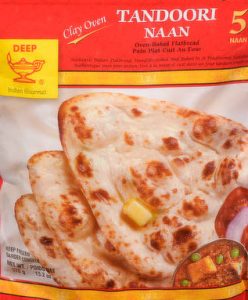
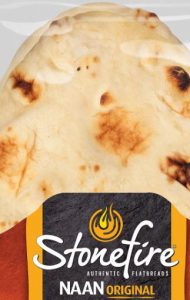
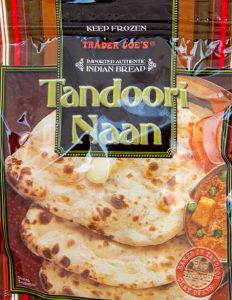
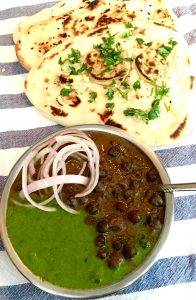
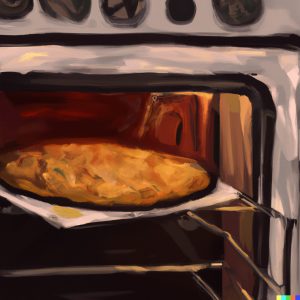
[…] our palak paneer with some warm Naan’s on the side. you can use our recipe for reheating frozen Naan’s. Palak Paneer Save Print Prep time 15 mins Cook time 10 mins Total time 25 […]
I excited to try right now!
Hi Melissa hope it turned out great, but if not feedback is welcome 🙂
Thanks this was brilliant! Worked very well on the Laccha paratha I had in the fridge.
★★★★★
Thank you very much Shreeya, makes us extremely happy when any of the posts are useful and people are kind enough to leave a note of feedback
Well I tried the oven method but came to dense.
Tried the pan method only a little better. Next time I will try this method of microwave and then to pan of high heat. Thanks
Well I tried the oven method but came to dense.
Tried the pan method only a little better. Next time I will try this method of microwave and then to pan of high heat. Thanks
I excited to try right now!
Oops posted twice. Will let y’all know how I did!
Looking forward to hearing how it turned out 🙂
So glad I found this tip!
I excited to try right now! this is your websait……